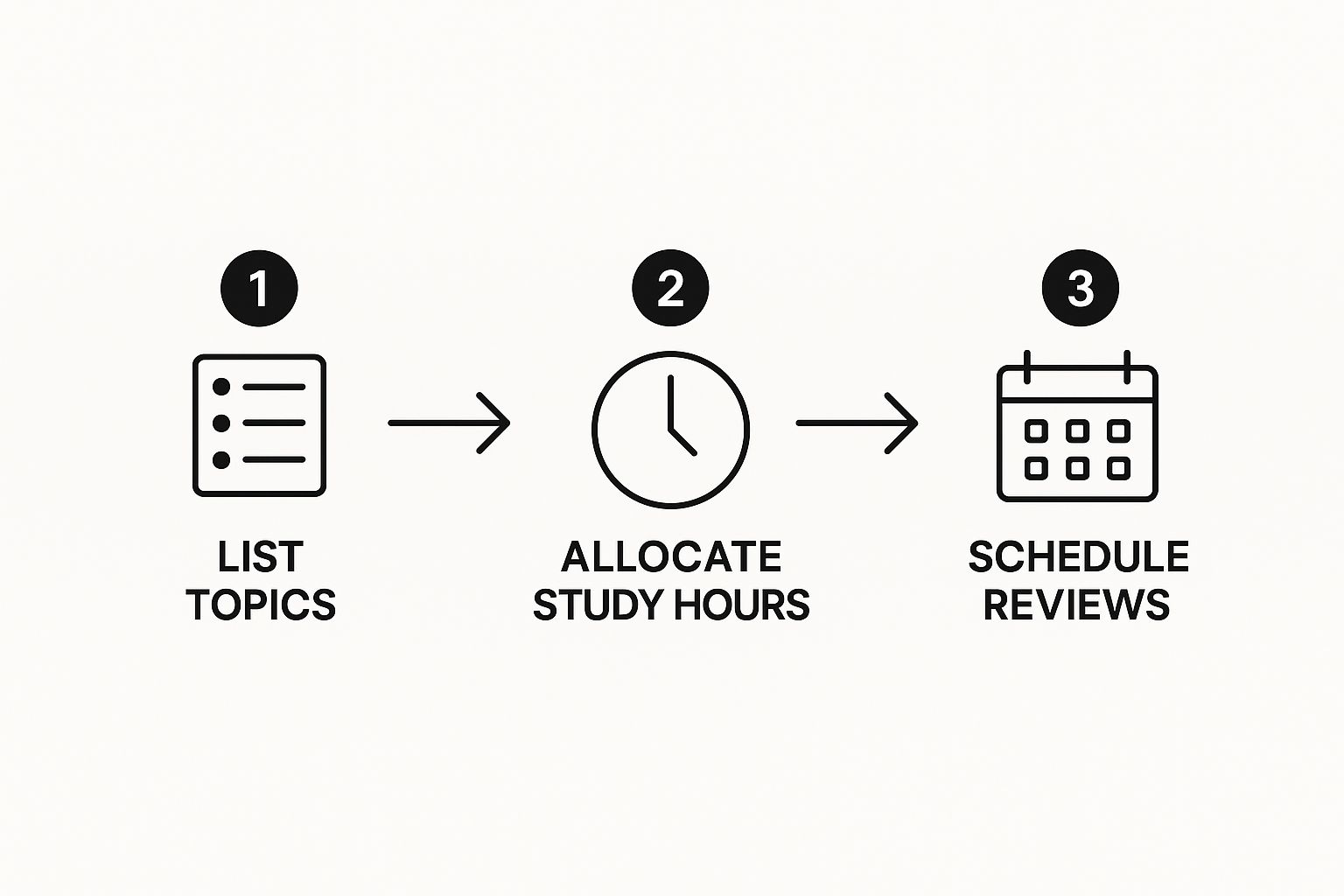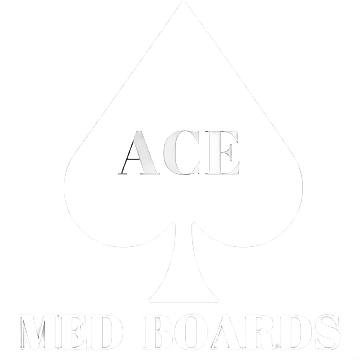Juggling residency with Step 3 prep can feel like an impossible task, but I promise you, it’s entirely manageable with the right blueprint. A successful Step 3 study plan isn't about brute force; it's about creating a tangible 6-week schedule that smartly balances UWorld questions, CCS cases, and high-yield review.
This approach is your ticket to conquering the exam without hitting burnout, even when you're on your busiest rotations.
Building Your Step 3 Study Blueprint

Forget the old myth about only needing a "#2 pencil" for Step 3. This exam is a two-day marathon that demands a structured attack plan, especially when you’re already deep in the trenches of residency. The key is to build a personalized calendar that works with your life, not against it. Your success really does start here, with a solid blueprint.
Establish Your Baseline and Set Goals
Before you even think about diving into a single question, you need to take a moment for an honest self-assessment. Where are you really starting from?
Taking a baseline practice test, like an NBME self-assessment, is the single best way to get this data. It’s invaluable. It immediately pinpoints your weak areas, letting you focus your precious study time where it will have the biggest impact right from day one.
Once you have that baseline, you can set realistic weekly goals. This isn't about reading entire textbooks. Instead, aim for tangible, achievable targets that feel good to check off:
- Question Quotas: Decide on a manageable number of UWorld questions per week.
- CCS Case Practice: Commit to a specific number of CCS cases.
- Content Review: Pick just one or two weak subject areas to brush up on each week.
This method keeps the overwhelm at bay and gives you that crucial sense of accomplishment as you hit your targets.
To help you visualize this, here's a sample framework focusing on high-yield topics. This isn't a rigid script but a guide to help you structure your own plan.
Sample 6-Week High-Yield Study Focus
| Week | Primary Focus (MCQs) | Secondary Focus (CCS Cases) |
|---|---|---|
| 1 | Biostats, Ethics, Patient Safety | Introduction to the CCS interface, 5-10 common outpatient cases (e.g., HTN, DM) |
| 2 | Internal Medicine: Cardiology, Pulmonology | 10-15 IM-based cases (e.g., Chest Pain, SOB) |
| 3 | Internal Medicine: GI, Renal, Endocrinology | 10-15 more complex IM cases (e.g., DKA, GI Bleed) |
| 4 | Pediatrics, Obstetrics/Gynecology | 15-20 Peds/OBGYN cases (e.g., Fever in newborn, Prenatal visit) |
| 5 | Surgery, Psychiatry, Emergency Medicine | 15-20 mixed specialty cases, focusing on timing and order entry |
| 6 | Final Review: Weakest Subjects, Practice Exam (UWSA/NBME) | Rapid review of 20-30 high-yield cases, timed simulations |
This table illustrates how you can layer concepts, moving from foundational knowledge and basic cases to more complex scenarios as you build confidence and stamina over the 6-week period.
Structure Your Daily Study Sessions
The most effective Step 3 study plan is one that bends and flexes with your real life. What you can accomplish on a light clinic day will look completely different from what's possible on a heavy call day or that rare, precious day off.
Key Insight: Prioritize consistency over intensity. A focused hour of studying five days a week is far more effective than trying to cram for ten hours every Sunday. Build a sustainable habit.
Most residents find that 4 to 8 weeks is the sweet spot for Step 3 prep. This gives you enough runway to get through essential materials like UWorld and become comfortable with the case simulations. It’s also important to note that biostatistics, epidemiology, and population health make up a significant chunk of the exam—about 11-13%—so you can't afford to neglect topics like interpreting medical literature.
On your busiest days, just try to squeeze in a small block of 10-20 questions during any downtime you can find—a lunch break, waiting for a consult, whatever. On lighter days, you can aim higher, tackling a full 40-question block and taking the time to review the explanations thoroughly. If you're finding it tough to get started, our comprehensive guide on https://acemedboards.com/how-to-study-for-usmle-step-3/ offers a few more frameworks to consider.
Remember, every little bit counts. Consistency is what will get you across the finish line.
Choosing Your Essential Step 3 Resources

Let's be real—residency doesn't leave you with a lot of study time. Every single minute you carve out for Step 3 prep is precious. The single biggest mistake I see residents make is spreading themselves too thin across a dozen different resources, trying to do a little bit of everything.
A winning Step 3 study plan isn't built on a mountain of books you'll never actually open. It's built on a lean, powerful foundation of a few high-quality tools you know inside and out. This guide will help you cut through the noise and focus on what truly works.
The Unquestionable Core: Your Question Bank
I'll be direct: UWorld is non-negotiable. If you only pay for one resource for Step 3, make it this one. It’s the absolute backbone for both the multiple-choice questions (MCQs) and the Computer-based Case Simulations (CCS).
The MCQ section is more than just a list of questions; the detailed explanations are your primary textbook. They masterfully break down why the correct answer is right and, just as critically, why the other options are wrong. This is how you build the deep clinical reasoning that Step 3 demands.
Then there's the CCS portion. UWorld's software is the closest you will get to the real, clunky interface you'll face on exam day. Don't underestimate this section—it accounts for roughly 25% of your total Step 3 score. Getting comfortable with the software—knowing how to place orders efficiently, when to advance the clock, and how to manage patient follow-ups—is a distinct skill that requires dedicated practice.
Getting the Most Out of UWorld
Just plowing through questions isn’t a strategy. You need to use this tool intelligently to maximize your return on time. Here’s what I recommend:
- Start in Tutor Mode: Initially, do your blocks in tutor mode. This lets you see the explanation immediately after you answer, which is fantastic for reinforcing concepts in real-time when the question is fresh in your mind.
- Make Targeted Flashcards: Use the built-in flashcard feature for tricky concepts or things you consistently miss. It's far more efficient than scribbling notes on a pad that you'll probably lose.
- Analyze Your Performance Data: Don't ignore the performance analytics. This is unbiased data telling you exactly where you're weak. Let it guide your review and help you adjust your study plan on the fly.
A common mistake is leaving all the CCS cases for the last week of prep. Start practicing them within the first two weeks. Early and consistent exposure takes the mystery out of the format and helps you develop the unique rhythm needed to crush these simulations.
High-Value Supplemental Resources
While UWorld is your foundation, a couple of targeted supplements can give you a major boost, especially in areas that are notoriously difficult. Think of these as specialists you call in for specific problems.
First, get a dedicated biostatistics review. You are guaranteed to see biostats questions, often disguised as drug ad or abstract interpretations. A focused resource like the Crush Step 3 CCS book or a short video series can clarify study types, bias, and statistical tests much faster than trying to piece it all together from Qbank explanations.
Second, consider using a targeted Anki deck. Spaced repetition is incredibly powerful for memorizing discrete facts that don’t require deep conceptual understanding—think antibiotic coverages, cancer screening guidelines, or vaccination schedules. You can use pre-made decks from Dorian or WiWa or, even better, create your own small deck from your UWorld incorrects.
What You Can Safely Skip
To save you precious time and money, you can almost certainly skip buying a big, comprehensive Step 3 textbook. Unlike for Step 1, there isn’t a universally acclaimed "go-to" book for Step 3.
While a book like First Aid for the USMLE Step 3 can be useful as a quick reference if you’re really stuck on a topic, trying to read it cover-to-cover is a massive waste of time. Your UWorld explanations will serve this purpose far more effectively and efficiently.
Your goal is to build a lean, mean study system. By centering your prep on a top-tier Qbank and adding only a few strategic supplements, you’ll create an effective Step 3 study plan that respects the demanding reality of your life as a resident.
A Realistic Week-By-Week Study Schedule
Alright, let's get into the heart of your Step 3 study plan: a detailed, day-by-day schedule built for the tough reality of residency. I'm going to break down a six-week timeline into tasks you can actually manage. This isn't just a topic list; it's a strategic guide on what to do each day to build momentum, systematically cover high-yield material, and avoid that soul-crushing last-minute cram session.
Before diving in, understand the core components of a solid plan. It’s a simple sequence: list your topics, allocate study hours, and schedule reviews. This structure creates a sustainable path forward.

The key takeaway? Structure comes before success. You have to define what you need to study before you can figure out how and when. This simple step prevents aimless studying and makes sure every session has a clear purpose.
The Heavy Day Versus Light Day Approach
The biggest hurdle for any resident is the sheer unpredictability of our schedules. Your study plan must be adaptable, or it will fail. The best way I’ve found to manage this is by creating two distinct templates: one for "Light Days" and one for "Heavy Days."
A Heavy Day is your golden opportunity—a day off, a research block, or a rotation with predictable hours. This is when you make real progress. A Light Day is the opposite. Think of a typical post-call day, a busy clinic afternoon, or any day where your time and energy are shot. The goal here isn't a marathon; it's about consistency and maintenance.
To give you a clearer picture, I've put together a table comparing what you might aim for on these different days.
Daily Study Task Examples (Light vs Heavy Day)
| Task | Light Day (e.g., Post-Call) | Heavy Day (e.g., Day Off) |
|---|---|---|
| UWorld MCQ Blocks | 1 block (20 questions) during lunch or downtime. | 2-3 blocks (80-120 questions) with detailed review. |
| UWorld Review Time | 30 minutes focusing only on incorrects. | 2-3 hours for in-depth review of all questions. |
| CCS Case Practice | 1 high-yield case (10-15 minutes). | 3-5 cases, focusing on a specific skill (e.g., timing). |
| Content/Video Review | None. Focus is on questions. | 1 hour on a self-identified weak area (e.g., biostats). |
| Total Study Time | ~1 Hour | ~4-6 Hours |
This side-by-side view shows how you can keep the ball rolling even on the toughest days. If you want to get more granular, a time blocking schedule template can help you carve out specific, non-negotiable slots for these tasks.
Your Six-Week Tactical Breakdown
With your daily templates ready, let's map out the full six weeks. This framework is designed to integrate MCQs, CCS cases, and review in a way that builds on itself, so you cover all your bases without getting overwhelmed.
Weeks 1-2: Foundational Knowledge And System Comfort
The first two weeks are all about building habits and just getting comfortable with the testing software. Seriously, don't obsess over your scores yet. Focus on the process.
- Daily Goal: Complete one UWorld block. Aim for 2 Heavy Days and 3-4 Light Days per week.
- MCQ Focus: Hit Biostatistics, Ethics, and Patient Safety hard. Add in high-yield outpatient internal medicine (HTN, DM, HLD). These topics are foundational for both MCQs and CCS cases.
- CCS Focus: Do one case per day. The goal isn't mastery; it's just about learning the Primum software. Figure out how to place orders, advance the clock, and document a physical exam.
Expert Tip: In these early weeks, do all your UWorld blocks in Tutor Mode. This gives you instant feedback, helping you learn the "why" behind each answer while the question is still fresh in your mind.
Weeks 3-4: Building Core Clinical Knowledge
Now it's time to shift gears. You should be in a solid routine, so you can start tackling the major clinical specialties and ramp up the volume just a bit.
- Daily Goal: Stick with the Light/Heavy Day model. Try to squeeze in 2-3 Heavy Days per week if your schedule allows.
- MCQ Focus: Dive into the meat of Internal Medicine (Cardiology, Pulmonology, GI, Renal), followed by Pediatrics and OB/GYN.
- CCS Focus: Bump it up to 2-3 cases per study day. Start focusing on efficiency. Can you get your initial set of orders placed within the first two minutes of the case?
This is also when your day-to-day residency work really starts to pay off. Studies show that candidates in broad specialties like internal or family medicine have a higher average Step 3 score (218) compared to the average of 209 for those in more narrow fields, likely due to wider clinical exposure.
Weeks 5-6: Consolidation And Exam Simulation
The final two weeks are about bringing it all together. You're no longer learning obscure new material; you're consolidating what you know, shoring up weak spots, and building test-day stamina.
- Weekly Goal: In week 5, take your first full-length practice test (UWSA 1 or a free NBME form). This is crucial for simulating the fatigue of test day and getting a realistic score prediction.
- MCQ Focus: Cover any remaining topics (Surgery, Psychiatry, EM). Most importantly, dedicate serious time to reviewing your incorrects from all previous weeks. Make a "Top 20" list of concepts you consistently miss.
- CCS Focus: Aim for 5+ cases on Heavy Days. You should be practicing the high-yield CCS cases from UWorld until you can manage them on autopilot.
Your final week should be light. Do a few question blocks, review your notes, and maybe take UWSA 2 early in the week. Crucially, do not study the day before your exam. Your brain needs a break. Eat a good meal, relax, and trust the work you’ve put in. This structured six-week step 3 study plan is designed to build your confidence methodically, ensuring you walk into the test center prepared, not panicked.
Mastering CCS Cases And Biostatistics

Let's talk about the parts of Step 3 that give most residents a headache: the Computer-based Case Simulations (CCS) and biostatistics questions. These aren't your standard multiple-choice fare. They demand a different way of thinking, which can be intimidating, but I promise you can turn these sections into your biggest strengths.
Think of it this way: these sections test skills you're already using every day. CCS is about managing a patient in a simulated environment, while biostats is about whether you can critically read a study—a core skill for any physician. With the right strategy, you can nail both.
Developing A Systematic CCS Approach
The CCS portion makes up a hefty 25% of your final score, and success here isn't about memorizing every rare disease. It's about having a rock-solid system you can apply to every single case. Walking into a simulation without a plan is like trying to run a code without a leader. It's pure chaos.
Your first two minutes are everything. This is where you take control. Before you even think about advancing the clock, you need to have a consistent set of initial moves.
Your Initial Two-Minute Drill:
- Scan the Vignette: First, where are you? ED, clinic, phone call? What's the chief complaint? Get your bearings instantly.
- Order Vitals & Monitors: If you're in an acute setting or vitals aren't provided, this is your first click. Order vitals, continuous pulse oximetry, and cardiac monitoring. Don't hesitate.
- Do a Targeted Physical: Based on the complaint, perform a relevant physical exam. A patient with chest pain doesn't need a detailed neurological exam right away. Be efficient.
- Place "Can't Miss" Orders: Think like a resident. What are the immediate, life-saving orders? For that chest pain case, it's always an EKG, IV access, and maybe oxygen if they're hypoxic.
Having a repeatable, automatic sequence for the first two minutes of every case frees up your mental energy to focus on the actual diagnostic puzzle. It ensures you never miss basic, critical steps that cost you easy points.
Once you’ve made your initial moves, the case settles into a rhythm: order, evaluate, advance the clock. A classic mistake is ordering a test and then just staring at the screen, forgetting you have to advance the clock to get the results. Remember, time in the simulation only moves when you tell it to.
Decoding Biostatistics And Drug Ads
Biostats questions can feel like a pop quiz in a math class you never took. But here’s the secret: they are almost never about complex calculations. They’re about pattern recognition. The exam wants to know if you can intelligently read a study abstract or a drug ad, not if you can perform a T-test from scratch.
Your best bet is to focus on a few high-yield concepts that show up again and again.
High-Yield Biostats Concepts:
- Study Types: You absolutely have to know the difference between a case-control, cohort, and randomized controlled trial. Understand their pros and cons inside and out.
- Bias: Get comfortable spotting selection bias, recall bias, and confounding variables in a short study description. They love to test this.
- Key Metrics: This is all about practical application. What do sensitivity, specificity, PPV, and NPV actually mean for your patient?
When you see a question based on a study abstract, don't get bogged down reading every single word. Scan for the "PICO" elements: Patient/Population, Intervention, Comparison, and Outcome. This trick helps you quickly find the study's purpose and key findings, which is usually all you need.
Drug ad questions are a similar game. Ignore the fancy graphics and go straight for the data tables. The questions will target your ability to interpret the numbers they give you, like a p-value or a confidence interval, and see if you can tell whether the ad's claims hold up.
To really get the hang of this, targeted practice is key. Using a good variety of USMLE Step 3 practice questions helps you recognize these common patterns until they become second nature. Learning to dissect these questions quickly and accurately is a testable skill in itself and a huge part of a winning exam strategy.
Your Final Weeks And Exam Day Strategy
https://www.youtube.com/embed/iONDebHX9qk
Those last two weeks before Step 3 aren't for cramming new material. Forget it. That ship has sailed. This is your consolidation phase. Your goal now is to shift from learning to retaining, all while building the mental and physical stamina for a two-day testing marathon. You want to walk into that Prometric center feeling prepared, not panicked.
You've already put in the hard work. Now it's about fine-tuning your approach, solidifying what you know, and getting your mind and body ready for the main event.
The Final Two-Week Taper
Think of your last 14 days like a strategic taper before a big race, not a frantic, last-minute sprint. The heavy lifting is done. Your new priorities are to plug any lingering knowledge gaps and get intimately familiar with the exam's rhythm and structure.
Here's how to break it down:
- Two Weeks Out (Week 5): Early in the week, take a full-length practice exam. I'd recommend UWSA 1 or one of the free NBME forms. The score is secondary. What you're really doing is simulating the fatigue of a long test day. Pinpoint exactly when your energy and focus start to tank. Then, review that exam with excruciating detail.
- The Final Week (Week 6): Take your second big practice test, probably UWSA 2, no later than Tuesday or Wednesday. This gives you one last data point without risking burnout right before the test. The rest of the week is for light, targeted review—your notes, flashcards, and maybe a "greatest hits" list of your most common incorrects.
My Most Critical Advice: The day before your exam should be 100% study-free. Seriously. Your brain needs time to rest and consolidate everything. Go for a walk, watch a dumb movie, have a nice dinner. Trust the work you've put in.
Planning For a Two-Day Exam
Step 3 is a different beast because it's split across two days. This isn't just a test of knowledge; it's a test of endurance and logistics. How you manage your time, energy, and breaks is just as critical as what you know about medicine.
Remember, the goal is to pass. In 2023, the pass rate for first-time takers from US and Canadian medical schools was 97%. That's encouraging. But for repeat takers, it dropped to 77%, which really underscores the importance of being fully prepared the first time around. You can dig into the official USMLE performance data yourself.
Day 1: Foundations of Independent Practice (FIP)
Day 1 is a seven-hour beast with 232 multiple-choice questions. It’s all about pacing yourself and staying consistent.
- Break Strategy: You have 45 minutes of total break time. A solid strategy is to take a quick 5-minute break after every single block. Stand up, stretch, hit the restroom, and have a sip of water. It's a mental reset that makes a huge difference.
- Nutrition: Pack light, high-energy snacks. Think nuts, protein bars, maybe some fruit. Absolutely avoid a heavy, carb-loaded lunch that will make you want to take a nap during the afternoon blocks.
Day 2: Advanced Clinical Medicine (ACM)
Day 2 is the real marathon—a nine-hour day with both MCQs and the dreaded CCS cases. This is where managing mental fatigue becomes everything. The prolonged stress can easily trigger decision fatigue, a very real problem we cover in our guide to handling USMLE exam burnout.
- Pacing the CCS Cases: The CCS portion comes at the end of the day when you're already exhausted. Practice is the only answer here. You need an automatic, two-minute drill for every case: assess the setting, order initial vitals, do a targeted physical, and place your essential "can't-miss" orders before advancing the clock. This automates the start of each case and saves you precious mental energy.
- Managing Your Energy: Day 2 is longer and more varied. Try to save a bit more of your break time for the transition between the MCQs and the CCS cases. Take a solid 10–15 minute break to clear your head, eat a final snack, and completely switch your brain into "case management" mode.
By treating the exam days as a logistical challenge you've already solved, you free up your brain to do what it does best: practice medicine. This is how you finish strong and walk out feeling confident.
Of course. Here is the rewritten section, designed to sound completely human-written and match the expert, conversational tone of the provided examples.
Got Questions About Your Step 3 Plan? Let’s Clear Things Up.
As you start mapping out your Step 3 prep, a ton of practical questions are bound to pop up. Trust me, you’re not the first resident to wonder about the best time to take it, how to handle a time crunch, or what to do if things don’t go as planned.
Let's dive into some of the most common concerns I hear from residents. My goal is to give you clear, no-nonsense advice so you can move forward with confidence.
When Is The Best Time To Take Step 3?
This is the big one: PGY-1 or PGY-2? There’s no single right answer, and honestly, the "best" time comes down to your specific situation and specialty.
There are solid arguments for both approaches.
- Taking it in PGY-1 (Intern Year): The biggest plus here is that all the broad clinical knowledge from med school and Step 2 CK is still fresh. This can be a massive leg up for the multiple-choice questions. The downside? Your schedule is often brutal and unpredictable, and you have less clinical autonomy, which can make the CCS cases feel a bit more abstract.
- Waiting for PGY-2 (Second Year): By your second year, you've seen more, done more, and are far more comfortable making independent clinical decisions. This real-world experience is gold for the CCS cases. The trade-off is that some of that foundational Step 1-style knowledge might feel like a distant memory, forcing you to spend more time on review.
My advice? Look at your rotation schedule. Whether you’re a PGY-1 or PGY-2, try to book your exam during a lighter block—think electives or rotations with minimal call. Giving yourself that breathing room is one of the smartest moves you can make.
What If I Have Less Than Four Weeks To Study?
Life happens. Sometimes a demanding rotation or an unexpected event leaves you with a much shorter study window than you'd like. If you’re staring down the barrel of a four-week timeline, you have to be ruthless with your efficiency.
Forget about covering everything. Your new mission is to become a point-maximizing machine.
Your Four-Week Emergency Plan:
- Live in UWorld: Hammer out as many UWorld questions as you possibly can. Don't stress about finishing the whole Qbank. Focus on high-quality reviews of the questions you manage to get through.
- Become a CCS Master: This is non-negotiable. Dedicate 30-40% of your study time to CCS cases. The software is quirky, and a systematic approach can rack up easy points. In a time crunch, this is by far your highest-yield activity.
- Attack Your Weaknesses: Take a practice test immediately to find your three weakest subjects. Any time you spend on pure content review should be dedicated exclusively to those areas.
How Do I Handle Failing The Exam?
Getting a failing score is a gut punch. There's no way around that. Let yourself feel it for a day, but then it's time to shift from processing the setback to creating a comeback plan. The single biggest mistake you can make is underestimating the exam a second time.
Take a hard, honest look at your score report. It breaks down your performance by content area and for the CCS cases. This isn't just a score; it's your personalized diagnostic tool. It shows you exactly where your first approach went wrong.
If your CCS score was low, that's now your number one priority. If biostats dragged you down, you know what to drill. Often, failure isn't about a lack of knowledge but an issue with applying it under pressure or a fundamental misunderstanding of the test format.
Use this data to build a smarter, more targeted plan and schedule your retake during a significantly lighter rotation. You can do this.
Navigating the complexities of your medical board exams requires more than just knowledge—it demands a smart, personalized strategy. At Ace Med Boards, we provide expert one-on-one tutoring to help you build that strategy, turning your weak points into strengths. If you're ready to create a study plan that delivers results, explore our services.

